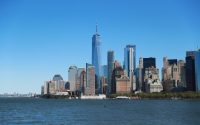Remote work costs Manhattan $12.4 billion per year: report
Hybrid office schedules are bleeding the Big Apple’s coffers of billions of dollars as employees continue to work from home, according to the results a recent study.
Manhattan-based workers are spending at least $12.4 billion less per year than they were before the COVID-19 pandemic drove a shift toward remote work, according to calculations conducted by Stanford University economist Nicholas Bloom’s WFH Research group and reported by Bloomberg on Sunday.
On average, Manhattan workers are spending about $4,661 less per person in the areas near their offices – the largest loss per employee of any major US city, the study found. The typical office has seen a 32.9% reduction in days worked on site.
“Less spending by workers in the central areas means a lot less sales tax revenue,” Jose Maria Barrero, a professor at Mexico’s Instituto Tecnologico Autonomo and a member for WFH Research group, told Bloomberg. “If you have fewer commuters, that means less revenue.”
New York City Comptroller Brad Lander warned that the trend represents a risk to the tax revenue needed to maintain high-quality services.

“If less income tax is being paid in New York City, then it’s hard to figure out how to capture enough value to maintain the subways and invest in the schools and keep the city safe and clean and all the things that really matter,” Lander told Bloomberg.
The researchers compiled the figure by multiplying the annual inflation-adjusted loss in spending per worker by the US Census Bureau’s estimate of approximately 2.7 million Manhattan-based workers in 2019.
Many companies have embraced a “return to work” model featuring a hybrid schedule, where employees work in the office for three or four days per week.

Data shows that office attendance – and employee spending – plunges on Mondays and Fridays, when many employees are working from home.
Foot traffic at eight major Manhattan office buildings is down by 45% on Mondays and a 52% on Fridays compared to 2019, according to data from analytics firm Placer.ai cited by Bloomberg.
While US retail spending on Fridays climbed 23% last October compared to the same month three years earlier, it was up by just 11% in Manhattan over the same period, according to data from Mastercard SpendingPulse.

As of the week ending on Jan. 25, office occupancy rates in New York stood at 47.5%, according to data from Kastle Systems. Across the US, office occupancy rates crossed the 50% threshold for the first time since the pandemic began.
Mayor Eric Adams has repeatedly urged companies with a presence in Manhattan to require their workers to return to the office. Last April, he warned poor office attendance could hurt the city’s recovery.
“It is a real concern,” Adams said. “We’re going to have to get to the table with all of our business leaders, our economists — and really, we can’t stumble into post-COVID.”


